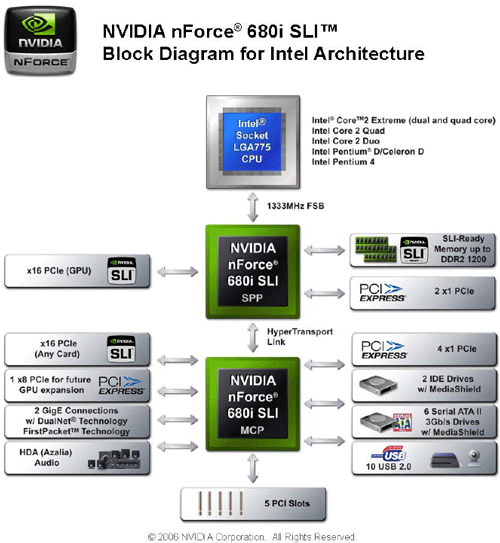Page 2
So the product we'll be testing today is an enthusiast targeted product. It's based on the nForce 680i (i for Intel) SLI chipset and the product is made by eVGA. The product is based 100% on a 6 layer PCB NVIDIA reference design and consists of two discrete chips, the 680i MCP and the 680i SPP. Similar to our 590I review, the 590 chipset, one x16 PCIe slot is controlled by each chip. This provides dual x16 SLI slots for the 680i.
There however is a very interesting new addition on the 680i, it is a third PCIe x16 slot between the x16 PCIe slots for SLI. This third slot is x8 PCIe instead of x16, but it could be used for another graphics card on the 680i. Obviously this x8 slot is also very suitable for a physics processor combined with SLI or in the future maybe 3-way SLI ?
What's also good to know is that the nForce 680i provides a total of 46 PCIe lanes, with 18 lanes available on the 680i SPP and 28 lanes provided on the 680i MCP. Lately I mention Core 2 Duo processors constantly as that really is what you should buy, but the mainboard supports Intel Socket 775 Core 2 Duo, Core 2 Extreme, Celeron D, Pentium 4, Pentium D 9XX, and Pentium D 8XX processors.
New features of the 680i are the addition of Extreme Overclocking capabilities and basic refinements of the features first introduced with the 590 SLI chipset. Features include:
Extreme Overclocking
- FSB speeds of 1333 MHz can be achieved with a CPU that supports this specification.
- DDR2 speeds of DDR2-1200 and beyond can be used to keep pace with overclocked system components. NVIDIA nForce 680i SLI MCPs support high-speed SLI-Ready memory
NVIDIA nTuneTM Utility allows adjustment of CPU and memory speeds without rebooting. There is also access to most BIOS settings from inside Windows.
True 2 x16 PCI Express SLI Support provided by two full-bandwidth, 16-lane PCI Express links.
Third PCIe Slot for Graphics Expansion
NVIDIA MediaShieldTM Storage includes RAID and SATA drive support.
- Multiple Disk Setup Through a wizard-based interface, you can set up your drives for better data protection, faster disk access or maximum storage capacity. MediaShield automatically selects a RAID 0, 1, 0+1 or 5 configuration according to your needs. Advanced users can access RAID options directly.
- DiskAlert System In the event of a disk failure, MediaShield users see an image that highlights which disk has failed to make it easier to identify, replace, and recover.
- RAID Morphing MediaShield allows users to change their current RAID setup to another configuration in a one-step process called morphing. This eliminates the need to back up data and follow multiple steps in the process.
- Bootable Multidisk Array MediaShield storage fully supports the use of a multi-disk array for loading the operating system at power-up.
- Six SATA 3Gb/s Drives Combine up to six SATA drives into one volume for bigger, faster RAID. Drives can be configured as six RAID 0 (striped) drives for maximum throughput, or Single or Dual RAID 5 arrays. Hot plug and Native Command Queuing are supported.
Networking with Dual Gigabit Ethernet with Teaming allows the two connections to work together to provide up to twice the Ethernet bandwidth.
High Definition Audio (HDA) can deliver 192 kHz/32-bit quality for eight channels.
USB 2.0 plug-and-play interface that provides easy-to-use connectivity for up to 10 USB devices.
As you can see that's quite a colorful palette of functionality and options.
So 95% of this boards features and options, is similar to that of the AMD board 590 and 680 board, except for LinkBoost. So with the nForce 680i you have to keep one thing in mind, it's built for the enthusiast gamer. It's major features therefore are Core 2 Duo processor compatibility, which obviously brings DDR2 memory into the ring as well. We'll talk about DDR2 in a minute as NVIDIA and a handful of memory manufacturers have brought some new features into this platform with EPP "SLI Ready" memory as well.

